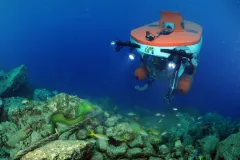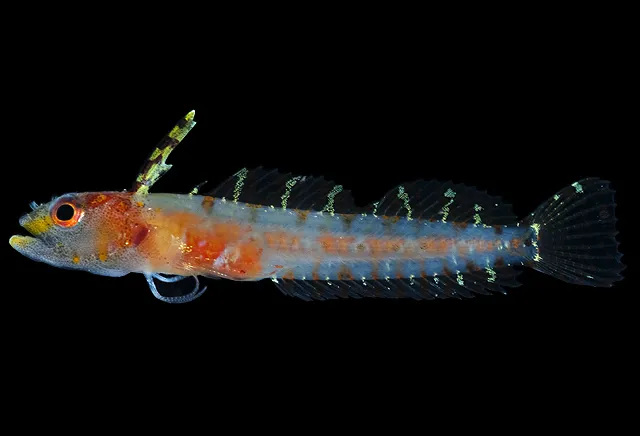A New Ocean Zone Described with the Help of a Submersible

Beneath vibrant coral reefs, but above the lightless depths of the sea, lies the “twilight zone” of reefs. The declining health of shallow-water reefs has inspired increasing scientific interest in the so-called “mesophotic” (meaning middle light) zone, which starts at depths of about 40 meters (130 feet). But what lies beyond the mesophotic zone? Scientists have begun to explore these even deeper and darker areas, recently dubbed the rariphotic (meaning scarce light) zone. The reefs there turn out to be home to a startling variety of sea life, much of it yet to be discovered.
The newly recognized rariphotic zone ranges from 130 meters to at least 309 meters (427-1,014 feet). It is too deep for corals with photosynthetic algae to grow, and it is also too deep for even the specialized SCUBA equipment used to explore mesophotic reefs. Submersibles and remotely operated vehicles can explore the region, but they are expensive and normally used to scope out even deeper depths of the ocean. As a result, most reef researchers seldom make it to the rariphotic zone.
But Dr. Carole Baldwin, a research zoologist at Smithsonian’s National Museum of Natural History, has now spent a good deal of time in this long-ignored zone. It was her team that conceived of the rariphotic zone, when they realized that the fish found there were not the same as those in the shallower mesophotic zone.
Baldwin began her “twilight zone” submersible dives when she received a phone call from Adriaan “Dutch” Schrier in 2010 The Curaçao-based entrepreneur and diving enthusiast owned a submersible that reaches depths of 1,000 feet, and he convinced Baldwin to join him on a couple of dives to help identify species below the shallow reef. The location is perfect for someone looking at deeper reefs, due to the island’s abrupt drop-off directly offshore.
On the first dive in the Curasub, she found several putatively new fish species. “I couldn’t have been more impressed,” Baldwin said. “I was seeing all these reef fishes that I didn’t recognize, and so right off the bat I knew that because those depths were just below what we could access with scuba gear, there was a whole realm there that we didn’t know much about.”
The idea of a new ocean zone was started on a hunch and just a little data. But thanks to rigorous analysis of a lot of fish-depth data accumulated over many years, the team was able to show that the fishes living in reef ecosystems below the mesophotic zone were distinct enough that the area they were inhabiting deserved a designation of its own.
Soon after the first dives, Baldwin created the Deep Reef Observation Project (DROP) in order to continue to explore the deep coral ecosystems, in the process discovering and describing numerous new species of fishes, crustaceans, echinoderms (a phylum that is best known for including sea stars), and mollusks. As Baldwin and her team made trips in the submersible, they kept track of the depths where the different fish species were found.
In total, the team observed 4,436 individual fishes belonging to 71 species during 80 submersible dives. Of these, 31 species belonging to 23 genera were mostly or only found in the rariphotic zone. Many of the species that Baldwin and her team observed and collected during the submersible dives are new. Since the project started in 2011, the DROP team has described 30 new species of fishes and invertebrates and six new genera, though Baldwin says the number of new species found is probably closer to one hundred when you consider those that are not yet named and described in scientific publications.
“Discovering new species is rarely one of those eureka moments,” she said. After Baldwin collects specimens representing presumed new species, she spends hours comparing color patterns and anatomical features, as well as analyzing DNA to verify the specimen is not a known species. When she does find new species, she likes to name them after donors and other people who have helped move the expensive project along. One of Baldwin’s favorites is the blenny fish, Haptoclinus dropi, named after the DROP program itself.
Thanks to this research, there are now three well-defined reef zones: the newly recognized and named rariphotic, the mesophotic, and the newly named altiphotic (meaning high light—surprisingly, the well-studied shallow water reefs also didn’t have a name before). Baldwin believes that naming the rariphotic and showing how distinct it is will inspire scientists to do more research in this previously neglected zone. Already she has heard from colleagues investigating deep-reef ecosystems off Bermuda that have observed many of the same rariphotic fish species that occur in Curaçao. Because DROP has discovered so many new deep-reef species off the coast of Curaçao, Baldwin believes there are a lot more to be found in mesophotic and rariphotic ecosystems at other locations around the globe.
This research also lays the groundwork for detecting future changes in reef biodiversity. With colleagues Ross Robertson, from the Smithsonian Tropical Research Institute and Luke Tornabene, formerly a Peter Buck postdoctoral fellow at the National Museum of Natural History, Baldwin’s next mission is to explore whether reef fishes are moving to deeper ocean depths in response to warming surface waters. Unpublished preliminary data suggest the answer may be yes.



